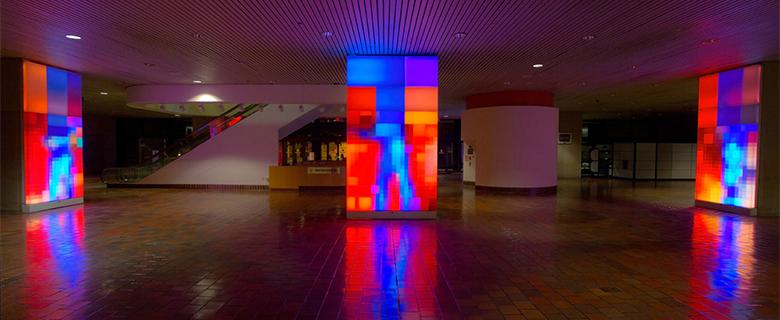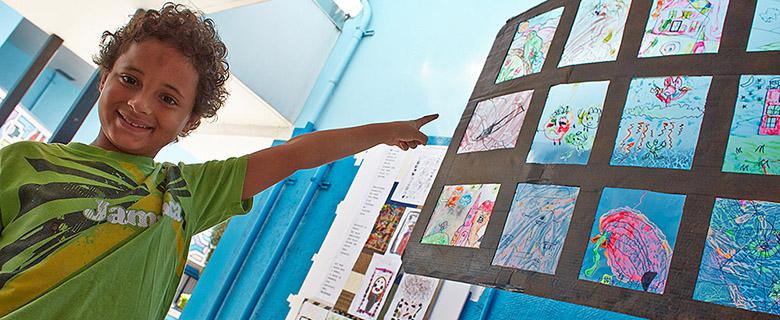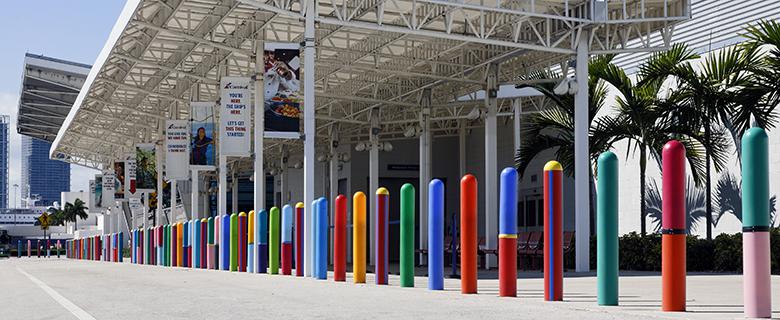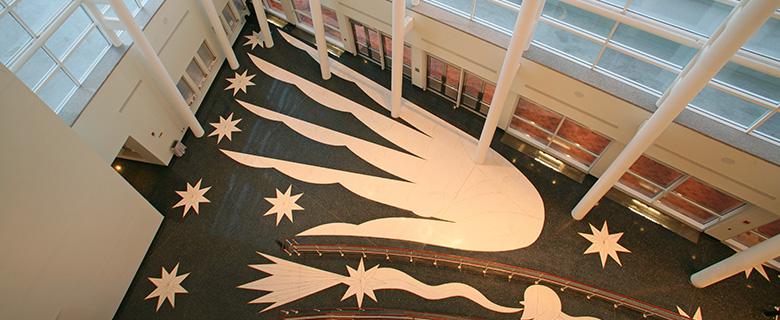Please review the frequently asked questions (FAQs) to understand more about the program, eligibility, what materials you need to apply, the evaluation and selection process, what happens if you are selected, and how to navigate the application platform, Submittable.
Helpful hint: If you are looking for more information about something specific and are viewing this page on a laptop or desktop, press the “Ctrl” key + the “F” key to search the page. A search box will appear in the top right corner of the screen and you can type a keyword or phrase to find where they appear in the FAQs.
THE MIA GRANTS PROGRAM, AWARDS, AND ELIGIBILITY
Q: What is the Miami Individual Artists (MIA) Grants Program?
A: The Miami Individual Artists (MIA) Grants Program provides merit-based awards to individual artists of all disciplines in Miami-Dade County on a competitive basis to support their artistic development and practice. In recognition of the contributions of Miami-Dade’s outstanding artists to the fundamental vitality and creativity of our cultural community, the MIA Grant Program strongly encourages applications from professional artists of the highest caliber with a recognized body of artwork, and who are deeply rooted in Miami’s diverse cultural life.
Q: What does this program fund?
A: The MIA Program provides awards to individual artists to support their artistic practice and endeavors as a whole. It’s not a “project-specific” program. Applicants will be asked to summarize their overall artistic pursuits, including any completed, tentative, and proposed plans, during the program funding period of October 1 – September 30.
Q: What is the maximum award a selected artist will receive?
A: Awards of up to $10,000 will be granted to selected artists. To maximize support and recognition, many awards will be offered in smaller amounts, allowing the Department to fund as many applicants as possible.
Q: Will every applicant be awarded?
A: Grant applications are considered on a competitive basis. Although your application may meet all the eligibility criteria and be incredibly meaningful, it will compete against hundreds of other applications in the same cycle, many of which are also exceptional. Due to the vast number of high-quality applications, panels often express their desire to recommend more grants than there is funding available. Not every applicant will be able to be awarded.
Q: If I receive a MIA Program award, can I spend the award on living expenses?
A: There are no restrictions on these funds and artists can use them in any way they would like, including living expenses. The payment will be made directly to the awarded artist or their Limited Liability Corporation (LCC), if preferred.
Q. Do I need to match the award with additional funding?
A: No, matching funds are not required. (Matching funds are money that the individual or organization must supply in proportion to the award as a requirement of being given the grant. The good news is that the MIA Grant does not require matching funds!)
Q: Who is eligible to apply?
A: Professional artists residing and working in Miami-Dade County for at least one (1) year at the time of application are eligible to apply. These include, but are not limited to, visual artists, media artists, composers, choreographers, playwrights, poets, actors, musicians, dancers, singers, performance artists, artisans, ceramicists, sculptors, traditional artists, folk dancers and folk musicians. In addition, artists must be over 18 years of age and actively pursuing their artistic practice between October 1st through September 30th.
Q: What artistic disciplines are eligible to apply?
Dance: including dance and body movement performance, choreography, and/or socially engaged dance-based practices.
Film/Media Arts: including experimental film, short film, animation, documentary film, narrative film, screenwriting, and/or socially engaged film/moving image-based practices.
Folk/Traditional Arts: including artistic practices that express a community’s cultural heritage and identity. These traditions are learned informally (through imitation, apprenticeship, etc.) and an artist’s excellence is recognized by their cultural community. Genres include: music, dance, crafts, dress/costumes, storytelling, and more.
Literary Arts: including poetry, fiction, nonfiction, graphic novels, and/or socially engaged literature-based practices.
Multi-, Inter-, Trans-, Post- Disciplinary Arts: referring to the combination of artistic disciplines, blending of knowledge, working beyond discipline, or challenging/discarding discipline altogether to create flexible and boundary-breaking artistic approaches and practice.
Music: including jazz, composition, music performance, vocal performance, sound art, and/or socially engaged music-based practices.
Theater: including acting, theater design, theater direction and creation, playwriting, and/or socially engaged theater-based practices.
Visual Arts: including painting, sculpture, drawing, photography, design, multimedia, installation, video art, performance art, and/or socially engaged visual art-based practices.
Q: Who is NOT eligible to apply?
A: Professionals who work directly with individual artists - such as curators, arts administrators, producers, or presenters; students pursuing undergraduate or graduate degrees, non-professionals who engage in the arts as a hobby; or employees and advisory board members of Miami-Dade County and their immediate families are not eligible.
Q: I’m not used to some of the terms used in the guidance, can you define them?
A: Here are some definitions for terms and ideas used in the guidance:
Unrestricted award: the grant money can be used according to the artist’s needs and desires and is not connected to a specific project or activity
Merit-based award: the grant money is awarded in recognition of artistic excellence and achievement
Competitive basis: the program has more applicants than awards available, so not every application will receive funding
Working professional artist: a person who has created a recognized body of artistic work over a sustained period and pursues this artistic work as a means of livelihood
Recognized body of artistic work: A recognized body of work means that your art and artistic practice are available for others to view and experience in a way that connects with industry standards. A body of work means having multiple projects and credits to your name. Industry standards are an established norm for how artists work within their discipline, with the standard activities and accolades that most people in the art world agree on and use.
A sustained period means that you’ve been producing art over several years, consistently.
Pursuing work as a means of livelihood means that a portion of your income results from your artistic work – you are paid for the results of the artistic practice.
Artistic practice is the way an artist approaches their work. It can refer to how they generate material, concepts they explore, their influences, ideas, materials, etc., and activities they engage in to share their art with the public.
Q: I do not receive income for my artistic practice. Can I still apply?
A: The definition of a working professional artist that the Department of Cultural Affairs uses to evaluate applications from individual artists is “a person who has created a recognized body of artistic work over a sustained period and pursues this artistic work as a means of livelihood.” We use this definition because we believe in paying artists for their work and want to validate the arts as a profitable profession. Additionally, the art industry standard is to compensate artists for their work. Therefore, applicants should receive compensation for their artwork to be eligible.
There may be disciplines in which this criterion is not applicable. For example, the Department understands that in the folk and traditional arts, getting paid for making art can be at odds with the practice's definition. Even the highest caliber folk and traditional artists may create their work for the public without receiving payment.
If you have questions about your eligibility, we urge you to contact the MIA Program Administrator to discuss your application.
Q: I am an artist who is part of an ensemble, dance company, theater production or artist collective. Am I eligible to apply as an individual artist?
A: Yes, artists affiliated with ensembles, artist collectives, duos or collaborative associations are eligible to apply; however, the artist endeavors and work samples presented in the application must reflect those of the applicant. If the work was developed collaboratively, applicants will be asked to indicate their specific role in creating or presenting the work.
Q: What if I am the artistic director of a non-profit arts organization? Am I eligible to apply?
A: Of course! Artistic directors would present their individual artistic practice in the application. While information should be provided about their role in the non-profit, focus should be placed on their artistry and art-making vs. administration of the organization.
Q: Can I submit more than one application in one cycle?
A: No, you may only submit one (1) application per cycle.
Q: Am I able to apply even if I was awarded in previous cycles of the MIA Grants Program?
A: Artists awarded in previous cycles are eligible to apply in future program cycles.
Q: Do I need to produce or present a project if I receive an award from the MIA Program?
A: As an awardee of this program, you commit to pursue the development of your artistic activities and practice during the program funding period between October 1 – September 30 of the granting period. Activities include, but are not limited to, performances, presentations, exhibitions, workshops, research projects and/or development/creation of new artwork. This award funds your artistic practice as a whole, not a specific project.
APPLYING
Q: My artistic practice falls into multiple disciplines; how do I know which discipline to apply in?
A: We encourage you to apply in the discipline that most closely relates to the work samples you provide in your application and what you plan to pursue in your creative practice during the granting period. By applying within a specific disciplinary category, the applicant chooses how to frame the discussion around their work and indicates which professionals are most qualified to evaluate their application.
If you have questions, you should contact the MIA Program Administrator to discuss which discipline best fits your application.
Q: What should I include in my Artist Statement?
A: An artist statement summarizes your artistic practice, work, medium, influences and unique creative pursuits. Simply put, an artist statement is what you do as an artist in 200 words or less. We suggest visiting https://grantspace.org/resources/knowledge-base/artists-statements if you need more assistance.
Q: What will I need to submit as proof of residency?
A: Proof of residency is required at the time of application. Documentation must include your name and address of residence in Miami-Dade County. Additionally, you must show that you’ve been a resident of Miami-Dade for one (1) year prior to the application deadline.
Acceptable forms of proof of residency include a FL driver’s license, property tax record, lease agreement, current voter’s registration, utility bill, or IRS Income Tax Return for the previous year. Permanent Resident Cards (i.e. “Green Cards”) and Passports are NOT acceptable since they do not include residential addresses.
NOTE: applicants providing copies of an IRS Income Tax Return are strongly encouraged to redact their personal financial information.
Q: What type of work samples am I required to provide as part of the application?
A: Work sample requirements vary by discipline, but all work samples should have been completed within the last three (3) to five (5) years prior to the application date. Work samples are requested in order to demonstrate the artist’s body of work, and range of work, and should indicate that the artist is actively engaged in their practice.
Literary Artists, Playwrights, and Screenwriters: three (3) writing samples up to ten (10) pages each, totaling no more than 30 pages.
Performing Artists (dance, acting, music and sound performance): three (3) video and/or audio samples of up to 10 minutes combined. Video with audio is the preferred, but not required, medium for panel review.
Music Composers: three (3) video and/or audio samples up to 15 minutes combined. OPTIONAL: Up to two (2) music scores in PDF or DOC format.
Film and Media Artists: three (3) video samples up to 30 minutes combined. Time-based media includes but is not limited to filmmaking, video-based artwork, etc.
Visual Artists: up to ten (10) images (high resolution). Visual artists who work in sound, installations, kinetic sculpture, and/or performance art may submit up to ten (10) minutes of video, audio, or dynamic media files in addition to still images to further describe their work. It is recommended, but not required, that visual artists submit more than one body of work to detail range of practice.
Multi-, Inter-, Trans-, Post- Disciplinary Artists: may choose to submit any combination of up to ten (10) images (high resolution), up to 15 minutes of video/audio samples, up to ten (10) pages of writing.
Folk/Traditional Artists: may choose to submit any combination of up to ten (10) images (high resolution), up to 15 minutes of video and/or audio samples. It is suggested, but not required, that a letter of recommendation be submitted from a representative of the community of the folk/traditional art practice.
Q: The work samples section on the application has a space for files and a space for links. Can I submit files and links?
A: Yes, you may submit a combination of files and links. However, each discipline has its own maximum number of samples – including files and links - an applicant is allowed to upload. Panelists will not review samples that exceed the maximum number allowed.
Q: What file formats are accepted for the work samples?
A: Acceptable file types include: pdf, jpg, jpeg, mp3, mp4, m4a, wav, mov, avi, mpg, 3gp, flv, webm, wmv, ogg, aac, flac, aiff, wma, mkv, m4v. Direct links to online content are also acceptable.
Q: What should I submit as work samples?
A: Work samples should provide evidence of your work as a professional artist and may include still images, short videos; audio or dynamic media files; writing samples (e.g., excerpt of poem, script or play), etc. Applicants may also submit images/videos related to the artistic endeavors noted in the application form.
It is advised that the work samples submitted are of high quality and present your strongest work. Please make sure you are including information such as title and date of work, location of performance or exhibit, medium and dimensions, full length of production or film, as applicable.
Q: How does the panel view my work samples?
A: Panelists will be reviewing work samples on personal computers through the Submittable platform. Please make sure you are including contextual information about your work samples including title, date, medium, dimensions, location, your role in the creation, and other helpful information for the panel to review.
Q: I see I have the option to submit support documents. What should I include?
A: You may submit up to three (3) support materials. Support documents should provide further confirmation of your work as a professional artist and may include documents such as catalogues, program books/playbills, postcards or flyers, news articles, letters of support, your website or social media links, etc. You may also submit videos in which you discuss your practice, process, and/or materials.
For Folk/Traditional artists, submitting a letter of recommendation from a representative of the community of the folk/traditional art practice validating artist’s practice will be beneficial for the panel to review, but is not a requirement for eligibility.
Q: You mention that I should describe my role in creating the artwork, especially if I am part of a collaboration, duo, collective or ensemble. What do you mean?
A: You should detail what you contributed to the creation of the artwork. The panel understands that often in collaborations it is difficult to decipher exactly which artist is responsible for what aspect of the art, but for this grant, the individual’s artistry is being assessed and the panel needs to be able to identify the applicant’s creative contribution.
For example, if you submit a dance piece that you co-choreographed and perform in, please note both contributions. If there are additional creative elements that you were responsible for (e.g. scenery, projections, costumes) you can note them as well.
Occasionally there may be multiple artists who hold the same title in an ensemble or collective. In that case, you may want to be more specific in your detail. For example, a producer on a film could have varying levels of creative involvement. To better inform the panel on your individual contribution, you could list the types of creative producing you were responsible for (e.g. “I identified and secured all casting and locations.)
Q: Can you give me some tips to make my application stand out and be more competitive?
A: Pay close attention to the evaluation criteria, this is what the panelists will use as a guide when reviewing your application.
Make sure you have great images and/or videos of your work with clear audio and high resolution.
Make sure your CV/Resume/Bio is up to date and professionally formatted.
Proofread your application. Have a friend/colleague review it before you submit.
Tell your whole story, showcase your practice, brag about your accomplishments.
Create a cohesive, consistent application so the panel understands your work clearly.
Give yourself time and avoid submitting at the last minute.
EVALUATION, SELECTION, NOTIFICATION, AND REPORTING
Q: How will the applications be evaluated and artists selected?
A: Applications will be evaluated by a peer review panel of experts assigned by discipline. All panelists are working professionals in the arts such as artists, curators, faculty members, arts administrators, etc. In addition to artistic expertise, age, gender, race, geography, relationship to arts and culture, and other factors are considered when convening application peer review panels.
Panelists will review all of your application materials individually (resume/cv/bio, artist statement, work samples, and proposed activities during the granting period) and then gather to review, discuss, and agree on their recommendations.
Q: What are the evaluation criteria?
A: Submissions will be judged by the following criteria:
Excellent artistic merit, accomplishments, and intention:
- Application and support materials demonstrate artistic excellence through an established, recognized body of artistic work and accomplishments over a sustained period.
- Application and support materials demonstrate consistency within the artistic practice.
- The work samples and information provided are relevant, cohesive, and demonstrate the artist’s potential to advance in their career.
Quality and scope of the artistic activities and practice pursued during the grant period:
- The quality and scope of the proposed artistic activities align with the applicant’s artistic practice and demonstrate a clear path for growth and development.
- The application clearly identifies ways the grant can positively impact the artistic practice.
Q: When will I know if I was selected or not?
A: Before notifying applicants if they have been selected for the MIA Grants program, the panel’s recommendations need to be approved by the Miami-Dade County Cultural Affairs Council, the Board of County Commissioners, and the Mayor of Miami-Dade County. This can often be a lengthy process, but notifications should be sent in the Fall of the award cycle with payments issued no earlier than December of that year’s award cycle for selected artists.
Q: How do I receive my grant payment?
A: Awardees will receive an award package including a grant agreement and other required documents plus instructions for completion. Once the grant agreement and paperwork has been properly filled out, it will be submitted for review and countersignature. All documents must be fully executed before the grant award can be processed. Awardees should expect this process to take at least 10-12 weeks.
Q: Will I be able to receive feedback on my application?
A: Once notifications have been sent to all applicants, applicants will be able to contact the MIA Grants Program administrator to ask for feedback on their application via email or a virtual consultation.
Q. What are the reporting requirements?
A: Selected artists will be required to provide a summary of their artistic endeavors throughout the program year. Awardees will have the option to provide additional documentation such as images, videos, press reports, etc. The deadline to submit the report is 45 days after the grant end date.
SUBMITTABLE
Submittable is the online platform that is used to accept the MIA Grants Program application. All applications and agreement paperwork must be submitted through this platform. If you have questions or need assistance in submitting your application, please reach out to the MIA Grants Administrator for support.
Q: Do I need a Submittable account to apply?
A: Yes, you need an account with Submittable to apply. It’s free to register and use. If you don’t have an account, you can sign up here: https://artinpublicplaces.submittable.com/signup?ReturnUrl=%2Fsubmit%2F211031%2Fmiami-individual-artists-mia-stipends-program
Please note that you should use an email address to create your Submittable login that you will have access to throughout the entire grant cycle (the application, award, and final report cycles). All communications will be sent via Submittable to this email address; you must be able to access them and respond promptly. HELPFUL HINT: Save your email address and password in a safe location.
If you have an existing Submittable account, you can sign in here. You must sign in to Submittable with the same email address that you used when setting up your account.
Q: How do I reset my Submittable password?
A: If you have a Submittable account but do not remember your password*, use either the Forgot? link in the Sign In page or this direct link to reset your password. Enter the email address that is associated with the account and click the ‘Send Directions’ button. An email will be sent to the account email address with a link to reset your password.
*You will need to remember the email address you used for your account!
Q: How do I edit an application that I have already Submitted?
A: The Department of Cultural Affairs may allow (or request) edits to a submitted application prior to the application deadline.
To request editing permission on an application, navigate to your submissions list and locate your application. Click the application title or number to open. Click the ‘Edit’ link in the right corner of the details page to submit your request to Department staff.
To edit an application, click on the submission in your account to open the details, then the purple ‘Edit’ button under the ‘Content’ or ‘Forms’ tab. Complete your edits and resubmit. DO NOT FORGET TO CLICK “SUBMIT” AT THE VERY BOTTOM OF THE APPLICATION BEFORE THE APPLICATION DEADLINE.
Q: How do I withdraw an application I have already Submitted?
Please note that if you want to make edits to your application, you do not need to withdraw it. Please see the guidance above to edit an application.
To withdraw your submitted application, navigate to the ‘Submissions’ tab at the top of your account homepage or click your username in the upper right-hand corner of the screen and select ‘Submissions’. Click on the ‘Active’ tab and choose the application you would like to withdraw. Select the ‘Withdraw’ option located at the top right of the submission details page, type a Reason for withdrawal, and click ‘Withdraw’.
Q: What are some helpful tips to keep in mind when using Submittable?
A: You can Save your application and return to it later, download a copy of your application for your files, and send messages to Dept. Staff.
Save your application as you work on it by clicking the "Save Draft" button at the end of the application webpage. You can log out, log back in, take a break, or work on your application over several days without losing your data.
To return to a draft application, navigate to the “Submissions” tab at the top of your account profile page and click ‘Saved Drafts.’ Locate the application you want to return to and click ‘Continue Working.’
Once you have completed your Application, don’t forget to click the "Submit" button at the end of the application webpage. You will receive an email confirmation that your Application has been submitted. Your submitted applications will be listed under the ‘All Submissions’ tab. Click on a submission to see activity, any messages, the submission content, or to add notes.
Print or download a copy of your Application by navigating to your "Personal Submissions" account list. Click on your Application submission. This will open the submission's details page, where you can click the Download button in the upper right.
Message Dept. Staff by logging into your account and clicking on Submissions. Click the title of the submission and select the Messages tab. You can add a subject, type your message, and even add attachments right in Submittable. When you are finished your message, click Send.
Q: How do I get technical assistance with my Submittable application?
A: For technical assistance on the application, visit Submittable’s Help Menu or send an email to their Support Team.
ADDITIONAL QUESTIONS? Email your question to Jane Thayer, Cultural Projects Administrator, at jane.thayer@miamidade.gov or schedule a 15-minute virtual meeting (click here). Questions will be answered during regular business hours (Monday – Friday, 9:00 AM – 5:00 PM).
It is the policy of Miami-Dade County to comply with all the requirements of the Americans with Disabilities Act. To request these materials in accessible format, please contact Stephanie Garcia at 305-375-4634 / culture@miamidade.gov, at least five days in advance to initiate your request. TTY users may also call 711 (Florida Relay Service).






